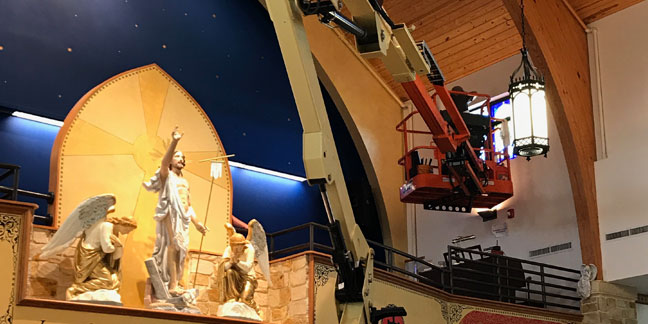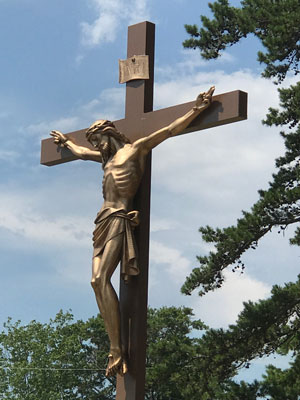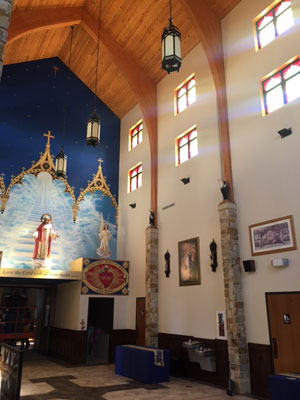 FOREST CITY — High windows in the narthex of Immaculate Conception Church have recently been replaced with stained glass, and a 20-foot crucifix has been erected on the church grounds – two beautification projects the pastor hopes will inspire everyone who comes into or passes by the Forest City church.
FOREST CITY — High windows in the narthex of Immaculate Conception Church have recently been replaced with stained glass, and a 20-foot crucifix has been erected on the church grounds – two beautification projects the pastor hopes will inspire everyone who comes into or passes by the Forest City church.
“Originally, I wanted those windows to be clear to allow light into the church so that it would be bright during the day even if the lights went out,” recounts Father Herbert Burke, pastor, “but some problems developed. At certain times of the day, the sun would beam directly into the eyes of the organist in the choir and certain parishioners in the church. So I started developing a plan that would give us a fundraiser that would help pay off the church and windows that would allow a lot of light to pass through, but still function somewhat like sunglasses.”
Statesville Stained Glass Co. was commissioned to craft a simple design by Father Burke meant to complement the larger stained-glass windows already installed in 2012. The 52 new windows feature a Gothic arch design, mirroring the arches found throughout the church, framed in cobalt blue, gold and red. Nameplates for each window were sold or chosen by Father Burke, and include the names of pastors and parishioners, the four bishops of Charlotte, St. John Paul II, Archbishop Fulton Sheen, and the Cornett family, who donated the land for the original parish church.
“So far, everyone who has seen them loves them,” Father Burke said. “I believe they add greatly to the beauty of the church and although I never originally intended them to be there, apparently God had other plans – which are, of course, always better than ours!”
A 20-foot wayside crucifix has also been placed on the church grounds, facing West Main Street, to inspire passersby. The life-sized bronze corpus was custom-made in Italy. The crucifix sits on a new plaza that will soon feature statues of angels, as well as benches for people to sit and pray at the foot of the cross.
Father Burke, who has been planning the project for two years, recently told The Daily Courier, “I prayed a lot about what words to put on it. I finally decided to simply use the words of Jesus, ‘Follow me.’”
— Photos provided by Father Herbert Burke


 CHARLOTTE — Seminarian J. Miguel Sanchez, who is studying at the Pontifical North American College in Rome, was admitted to candidacy for holy orders by Bishop Peter J. Jugis during Mass July 7 at St. Patrick Cathedral in Charlotte. Sanchez’s home parish is St. Francis of Assisi Church in Lenoir.
CHARLOTTE — Seminarian J. Miguel Sanchez, who is studying at the Pontifical North American College in Rome, was admitted to candidacy for holy orders by Bishop Peter J. Jugis during Mass July 7 at St. Patrick Cathedral in Charlotte. Sanchez’s home parish is St. Francis of Assisi Church in Lenoir.
He is pictured with his family who were in attendance for the Mass. The Rite of Admission to Candidacy for Holy Orders is celebrated when a seminarian, usually in his second year of graduate study, has reached a maturity of purpose in his formation and has demonstrated the necessary qualifications for ordination.
In the presence of the bishop, he publicly expresses his intention to complete his preparation for holy orders and his resolve to fully invest himself to that end, so that he will serve Christ and the Church.
— John Cosmas | Catholic News Herald

 CHARLOTTE — “It was lit!”
CHARLOTTE — “It was lit!”
That’s how members of Our Lady of Consolation Church’s Youth In Action group described their experience at the 12th National Black Catholic Congress in Orlando, Fla., July 6-9.
The goal of congress attendees was to learn about issues impacting the African American community and then leave equipped with the tools necessary to serve and better our brothers and sisters. The event’s theme was “The Spirit of the Lord is upon me: act justly, love goodness and walk humbly with God.”
The congress provided a particular opportunity for black Catholic teenagers from all over the United States to connect, learn and worship together. This had a huge impact as more than 200 teens gathered together – listening, learning, sharing and interacting with each other.
YIA members said they did not know what to expect before the congress, but they agreed that the experience would probably push them out of their comfort zone. By the end of the congress, they saw it as an eye-opening, extraordinary experience that sparked their faith and inspired them to more closely follow the teachings of Christ.
“I felt like I was a part of something – a big family, the Catholic family,” said YIA’s president, Devine Drummond. “It was a joyous, inspiring and exciting experience that united members of God’s black Catholic family.”
YIA members said the congress enlightened them in their Catholic faith, opening their eyes and minds to the importance of growing spiritually.
“It took us one step further into our journey with God,” said YIA member Christelle Mukoko.
Rosheene Adams, director of the Diocese of Charlotte’s African American Affairs Ministry, noted, “In today’s society, polarized by increases in racial violence and killings of unarmed blacks by police, we were all challenged to be true evangelizers, speak out against the social injustices of today and focus on people who are in need.
 “We were encouraged to engage our youth, create leadership positions for them and foster ‘true’ collaboration between current and future leadership within our parishes.”
“We were encouraged to engage our youth, create leadership positions for them and foster ‘true’ collaboration between current and future leadership within our parishes.”
Adams said of all the speakers at the congress, one message particularly hit home: “Bishop Edward K. Braxton of Belleville, Ill., urged everyone to ‘do something to know their history and to engage in their community.’ They must exercise their right to vote, participate in public life, run for public life and inspire young people to get involved. He left everyone with the requirement to ‘listen, learn, think, act and pray.’
“We (African American Catholics) need to get into real conversations with others in the community about our history so we can all grow in knowledge.”
Overall, their congress experience was a gateway to new knowledge, YIA members said.
They learned more about the exemplary life of Father Augustus Tolton, the first black priest in the United States; they learned about the liturgy of the Mass; and they attended discussion sessions designed specifically for the issues that young people face today.
Even though they shared many different views in some of the discussion sessions, they agreed that Jesus is always there to help them through their everyday challenges and struggles.
YIA members also expressed gratitude to those who made their trip to the National Black Catholic Congress possible, including the Diocese of Charlotte, pastor Father Carl Del Giudice and the members of Our Lady of Consolation Church.
— Amily James, Florence Okoro and Jackie Diouf, Special to the Catholic News Herald. Amily James, Florence Okoro and Jackie Diouf are members of Our Lady of Consolation Church’s Youth In Action group.
 CHARLOTTE — St. Matthew Church held its 15th Annual World Hunger Drive July 15, with 1,500 volunteers packaging 341,280 meals weighing more than 50,000 pounds to feed the hungry in Haiti and Jamaica.
CHARLOTTE — St. Matthew Church held its 15th Annual World Hunger Drive July 15, with 1,500 volunteers packaging 341,280 meals weighing more than 50,000 pounds to feed the hungry in Haiti and Jamaica.
With the 2017 theme “Feeding the Body, Mind & Spirit,” the annual drive also provides items of sustainability such as funding for education, irrigation, a tilapia farm, chickens, physical therapy and more to those in need in Haiti and Jamaica. Food products and packed meals are also shared with local food banks.
Over the years, 1.5 million meals have been packaged by World Hunger Drive volunteers at the Meal Packing Event. This year’s event exceeded its goal of packaging 300,000 meals over the course of four shifts. Volunteers have donated more than 33,000 service hours to the event over the past six years.
The event is conducted with the help of Servants With a Heart, a local non-profit that has packed more than 11.6 million meals working with 71,000-plus volunteers in the past seven years.

 The annual drive has flourished under the leadership of Monsignor John J. McSweeney, who recently announced his retirement after 42 years of priestly ministry. An anonymous donor made a gift of $250,000, in honor of St. Matthew’s longtime pastor, to establish an endowment for the World Hunger Drive that will sustain the charitable work for years to come.
The annual drive has flourished under the leadership of Monsignor John J. McSweeney, who recently announced his retirement after 42 years of priestly ministry. An anonymous donor made a gift of $250,000, in honor of St. Matthew’s longtime pastor, to establish an endowment for the World Hunger Drive that will sustain the charitable work for years to come.
Mark Creasser, parish volunteer coordinator for the drive, said the event is unique for the parish in that it brings together people from all generations to pack the meals. “Believe it or not, people schedule their vacations around it,” he said.
St. Matthew Parish has current goals of collecting one truckload of meal packages and four truckloads of food and supplies for Haiti, two truckloads of food and supplies for Jamaica, and more than 15,000 pounds of food for local pantries. In addition, one-and-a-half virtual truckloads of sustainability items such as farm products and irrigation supplies are to be sent overseas to those in need.
— Catholic News Herald. Photos by Tara Heilingoetter | Catholic News Herald



 Come along on a Fatima Peace Pilgrimage with the Catholic News Herald’s senior reporter SueAnn Howell July 20-Aug. 1. This annual pilgrimage to Fatima, Portugal, is organized by the Te Deum Foundation, which brings seminarians to the Shrine of Our Lady of Fatima every summer so the men can develop or deepen their devotion to Mary as part of their preparation for the priesthood.
Come along on a Fatima Peace Pilgrimage with the Catholic News Herald’s senior reporter SueAnn Howell July 20-Aug. 1. This annual pilgrimage to Fatima, Portugal, is organized by the Te Deum Foundation, which brings seminarians to the Shrine of Our Lady of Fatima every summer so the men can develop or deepen their devotion to Mary as part of their preparation for the priesthood.
This year’s pilgrimage promises to be special, as it marks the 100th anniversary of the apparitions of Our Lady at Fatima. Pilgrims and clergy
from the Diocese of Charlotte, as well as others, will be making the
journey.
Pope Francis recently canonized Sts. Francisco and Jacinta Marto, two of the shepherd children of Fatima. Pilgrims will tour their home and visit their parish church and have an opportunity to venerate these young
saints. A stop at the Carmelite convent where the late Sister Lucia, the oldest of the visionaries, lived as a cloistered nun is also planned.
Come with us as we grow closer to the saints of Fatima and Our Lady, Queen of Peace, on this 13-day pilgrimage during the centennial anniversary of Fatima and this Marian Year in the Diocese of Charlotte.
Follow SueAnn’s blog at: www.fatimapeacepilgrimage.tumblr.com

